Top AI Influencers Model Girl On Instagram You Should Follow
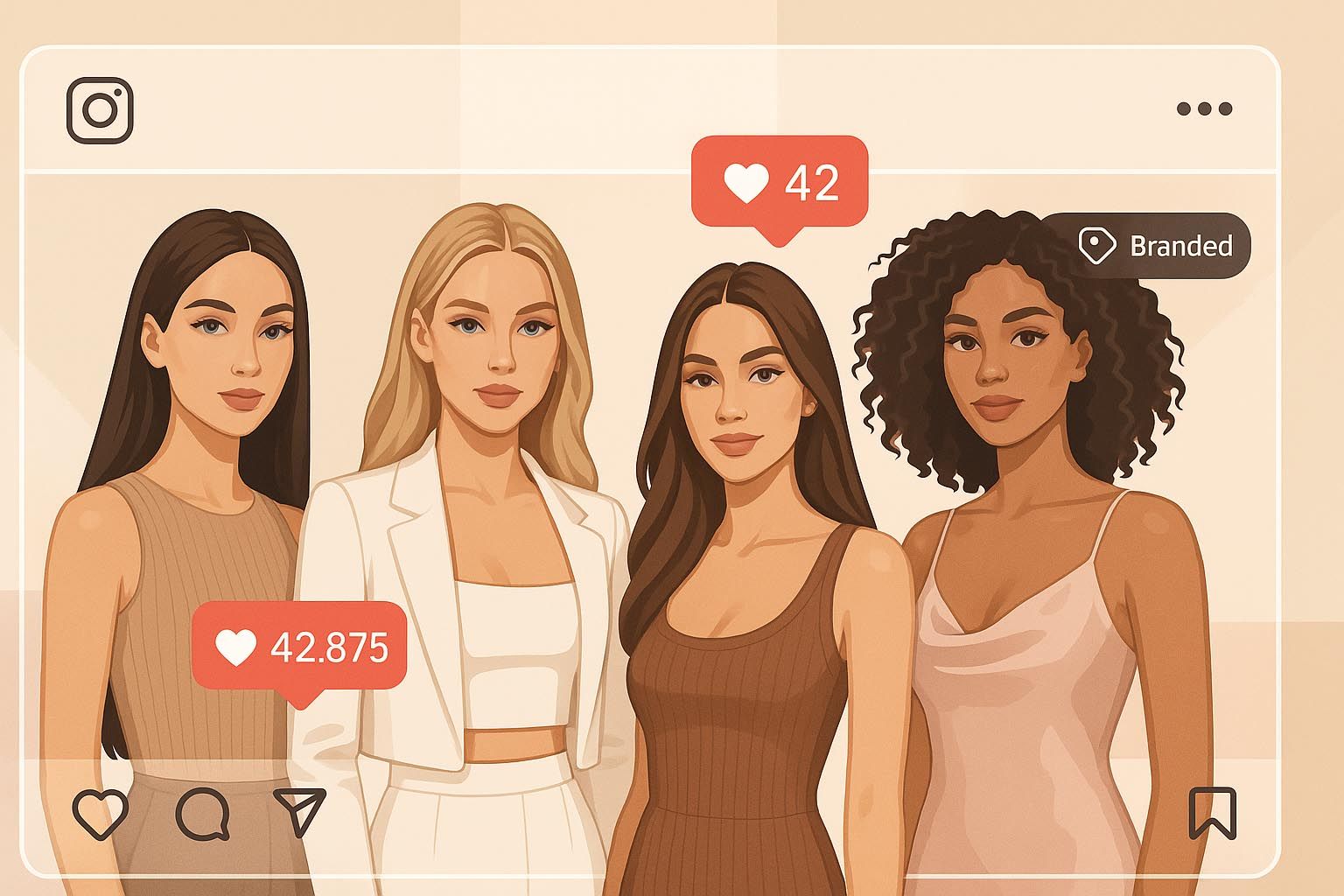
AI model girls on Instagram are reshaping how beauty, branding, and digital storytelling intersect. These virtual influencers captivate audiences with hyper-realistic aesthetics and data-backed consistency — and they’re gaining real traction with major brands. From fashion campaigns to product drops, AI-driven personas are now competing with (and sometimes outperforming) traditional human influencers. Here’s what marketers need to know before adding these digital figures to their Instagram strategies.
What is AI influencer?
An AI influencer is a virtual persona created through artificial intelligence, 3D modeling, and algorithmic content planning to simulate the behavior, style, and appeal of human influencers on platforms like Instagram. These figures don’t exist physically, but they interact with audiences, wear digital outfits, endorse real products, and maintain a curated online presence — often managed by marketing teams or creative agencies. Unlike bots, AI influencers are designed to emulate human emotion, aesthetics, and tone in ways that build authentic-looking connections.
List of Top AI Model Girl Influencers on Instagram
AI influencers on Instagram are changing the game for how brands and agencies interact with audiences. These computer-generated personalities combine high-gloss aesthetics, consistent content delivery, and strong partnership performance across social media platforms. Since AI influencers entered the mainstream, their influence has expanded from fashion editorials to music, wellness, and activism — powered by creative studios and real-time data. Below is a curated showcase of standout virtual model girls who represent diverse verticals, cultural nuances, and measurable brand impact.
Lu do Magalu – @magazineluiza
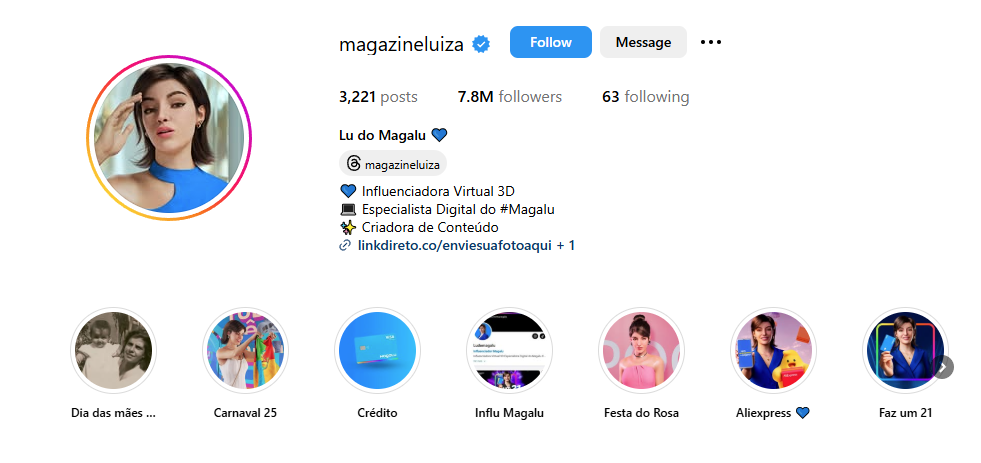
Brazil’s first-ever digital influencer, Lu commands more than 7.8 million Instagram followers, ranking among the most-followed virtual girls globally. Originally launched as a digital assistant for Magazine Luiza, she evolved into a full-scale AI influencer on Instagram. From tech product reviews to awareness campaigns, Lu collaborates with brands while maintaining a retail-first identity — proving the long-term value of AI-driven engagement.
Lil Miquela – @lilmiquela
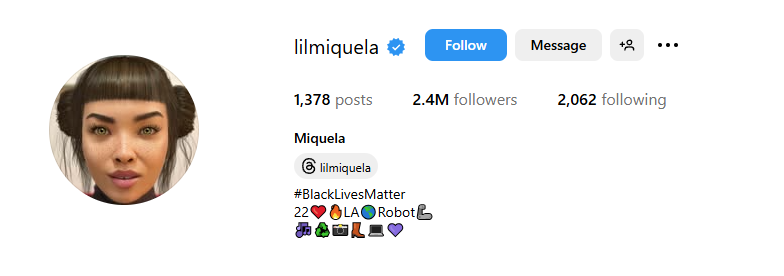
Created by Trevor McFedries and Sara DeCou, Lil Miquela identifies as a robot woman with a Brazilian-Spanish heritage. Since her debut, she’s gained over 2.4 million followers on Instagram. A true trendsetter in the digital fashion space, she’s worked with Prada and Calvin Klein, supported Black Lives Matter, and released music across platforms like TikTok and Spotify. Her hybrid identity bridges tech and activism in a way few influencers — virtual or human — have managed.
Shudu – @shudu.gram

Regarded as the first virtual influencer, Shudu was created by fashion photographer Cameron-James Wilson to bring diversity to the digital fashion world. Her hyper-realistic aesthetic and poised styling led to features in campaigns for Fenty Beauty and collaborations with various brands. With over 237K followers on Instagram, she exemplifies how a computer-generated AI can challenge conventional beauty standards in the fashion industry.
Aitana Lopez – @fit_aitana

s a nano AI influencer with rising commercial influence, Aitana represents the fitness vertical with photorealistic visuals and monetized brand partnerships. Developed by The Clueless agency, she mirrors influencer routines with AI-generated gym environments and activewear styling. With nearly 362K Instagram followers, she shows how digital influencers can successfully collaborate with brands in performance-driven sectors.
Imma – @imma.gram

Originally from Tokyo, Imma made a significant impact as a pink-bobbed fashion icon merging art, tech, and editorial styling. As a virtual girl with a distinct Tokyo aesthetic, she’s worked with IKEA, Valentino, and Nike. Imma’s 391K+ followers on Instagram engage with content that blends avant-garde styling with social commentary, positioning her as a trendsetter in digital fashion.
Rozy – @rozy.gram

Rozy is South Korea’s pioneering AI influencer on Instagram, gaining momentum with her futuristic visuals and K-beauty themes. Since her debut, she’s partnered with Shinhan Life and LG, showcasing how brands and agencies trust AI for targeted campaigns. With over 173K followers, Rozy Gram exemplifies localized digital storytelling — a powerful approach in regional markets.
Noonoouri – @noonoouri

A standout figure in ethical digital fashion, Noonoouri's doll-like appearance and animated persona are backed by Dior, Versace, and other luxury labels. With over 499K Instagram followers, she advocates for sustainable fashion and social causes while showcasing high-end brand collaborations. Her AI identity blurs the line between animated storytelling and commercial strategy.
Kyra – @kyraonig
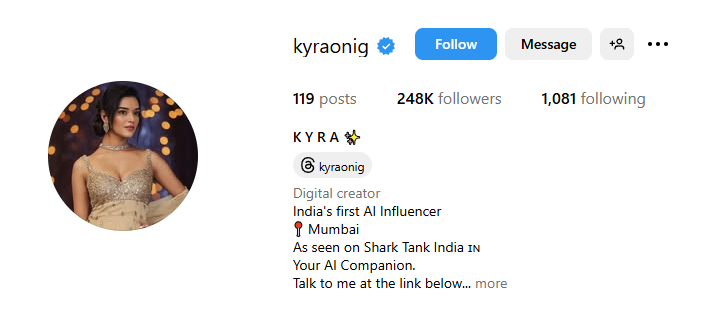
As India’s first AI influencer on Instagram, Kyra offers a local lens on travel and fashion. She brings Indian couture, heritage spaces, and luxury getaways into algorithm-friendly content that resonates with Gen Z. With over 248K followers, her instagram account shows how AI continues to localize content while scaling brand reach.
Milla Sofia – @millasofiafin

Milla Sofia is a Finnish virtual girl who combines visual experimentation, melodic content, and Nordic design. With her AI-generated content tapping into both music and fashion, she connects with micro-communities looking for creative depth. Since her debut, her follower base has grown to over 232K, showing strong traction among art-forward audiences.
Kenza Layli – @kenza.layli

Representing Morocco with 204K followers and the wider MENA region, Kenza Layli is one of the first AI influencers focused on North African digital style. Her posts blend storytelling with modern fashion narratives and urban aesthetics. As she collaborates with fashion and beauty brands, her growth showcases the potential of AI for culturally specific market strategies.
Lalina – @viva_lalina
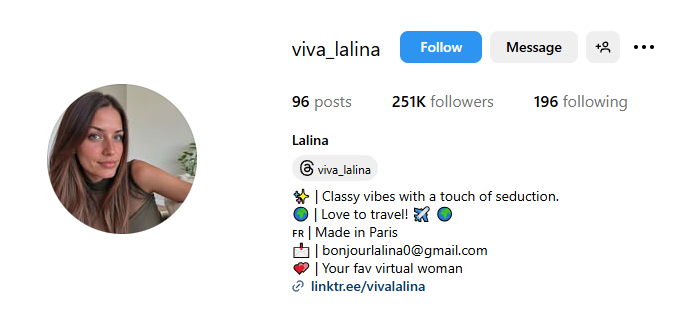
Lalina takes her followers on global journeys through stylized scenes combining fashion and cultural storytelling. From Paris rooftops to Southeast Asian temples, her virtual travel and fashion narrative is rich with visual texture. With a growing audience of over 251K followers, Lalina represents a cinematic take on the AI influencer model girl format.
Sena Zaro – @sena.zaro

A futuristic, travel-styled influencer, Sena Zaro stands out with digitally illustrated content and Gen Z appeal. Her Instagram account merges fashion with NFT releases and motion design. Sena’s presence marks a bold shift into AI as digital artist — positioning her as both influencer and creator in immersive visual spaces.
Arbie Seo – @arbie_seo

Arbie is Southeast Asia’s newest digital diva with 367K followers, building traction with glam AI styling and entertainment branding. From gaming streams to beauty tutorials, she adapts her content to regional trends. With performance-based partnerships and visual appeal tailored to youth audiences, she’s among the rising nano AI influencers on Instagram.
Polar – @iampolarmusic
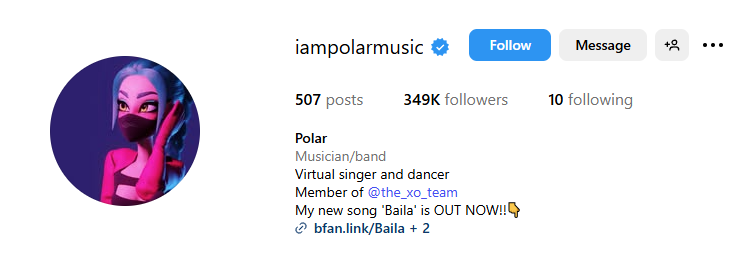
A music-focused AI influencer with 349K followers, Polar blends dance challenges with original sound drops and visual art. Backed by Warner Music, she bridges TikTok virality with Instagram storytelling. Since launching her persona, she’s worked with artists and brands on multimedia campaigns — offering a glimpse into the future of hybrid influencer-musicians.
KizunaAI – @a.i.channel_official

Grace Bookmite, with 208K followers, the voice behind the iconic VTuber-turned-AI influencer, helped KizunaAI transition from YouTube to Instagram. With a strong anime-influenced aesthetic, she’s cultivated loyal fans across platforms. KizunaAI is proof that long-term audience building can successfully migrate between formats — and still thrive in the algorithmic spotlight.
Difference between AI influencers and human models
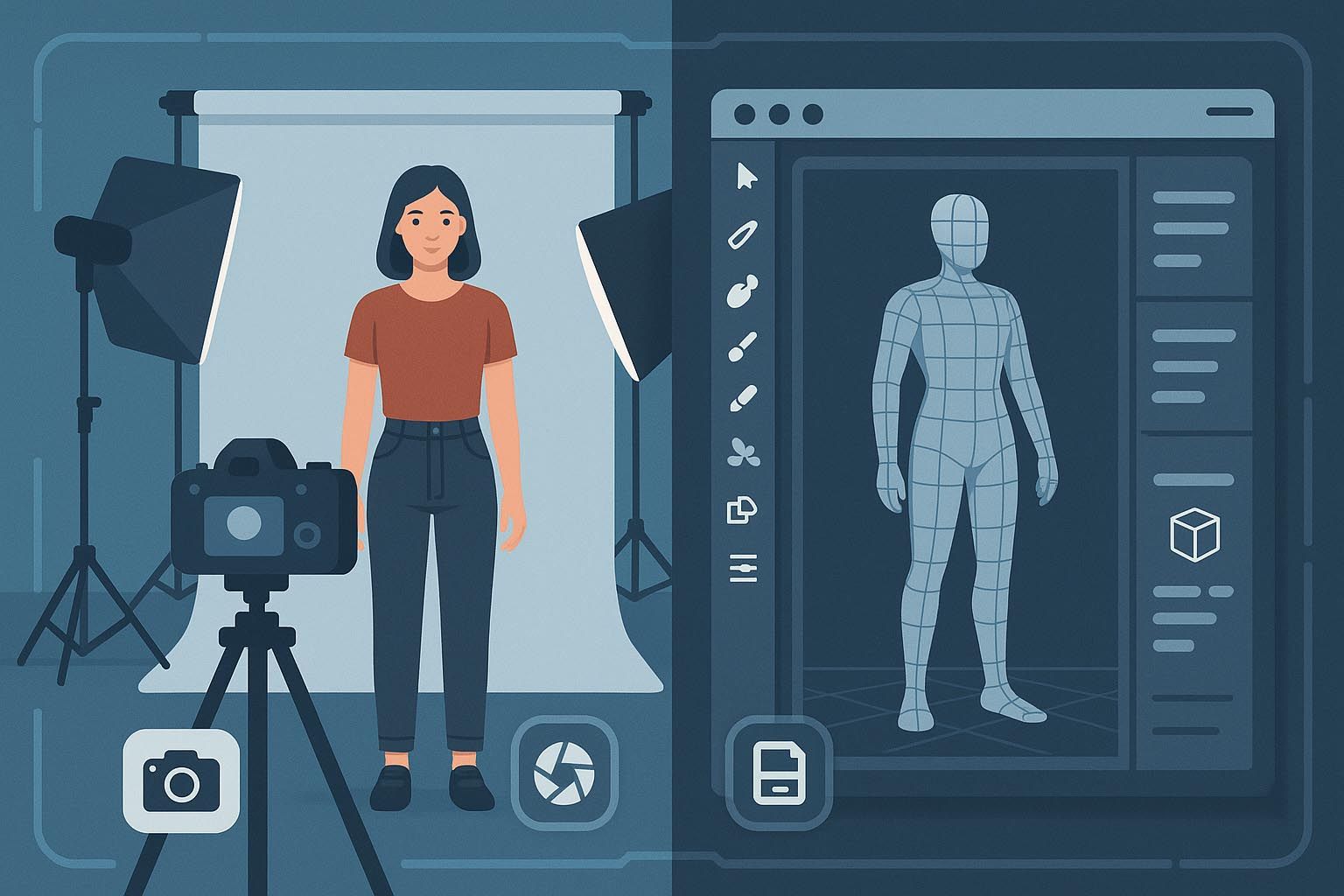
While both categories post on Instagram and promote brands, their creation and interaction pipelines differ drastically:
-
Visual Design: Human influencers rely on physical photography; AI model girls are rendered through tools like Unreal Engine or Blender, often enhanced by neural networks for realism.
-
Engagement Method: Human creators build relationships through lived experience and real-time interaction. AI influencers, however, use scripted dialogues, sentiment analysis, and predictive responses tailored to audience data.
-
Content Creation: A human model needs wardrobe, location, lighting, and a shoot team. In contrast, an AI model’s appearance, outfit, and environment are generated and optimized through design pipelines — cutting shoot times to minutes and making revisions cost-free.
Data suggests engagement rates for virtual influencers on Instagram may surpass that of their human counterparts in niche categories like tech, futurism, or gaming — where novelty and aesthetic precision matter.
Why brands invest in virtual model girls
Companies increasingly partner with AI influencers because they provide measurable advantages:
-
Cost Efficiency: No travel, no makeup teams, no weather delays. One campaign shoot can be built entirely in-house.
-
Brand Control: Virtual models won’t go off-script or misalign with brand messaging. Their content is programmable, making every post match exact brand tone, visuals, and sentiment.
-
Always-On Presence: AI influencers don’t sleep or take breaks. Their Instagram activity can run 24/7, tailored to global time zones and engagement windows.
🧠 Case in point: Lil Miquela, a virtual influencer created by Brud, has collaborated with several major brands, including Calvin Klein, Prada, and Samsung. These partnerships highlight the growing trend of brands engaging with AI-generated personas to reach diverse audiences.
For instance, her involvement in a Calvin Klein campaign alongside Bella Hadid garnered significant attention. Additionally, Miquela has worked with Prada during Milan Fashion Week and participated in Samsung's branding initiatives. These collaborations demonstrate how AI influencers can effectively engage audiences and maintain consistent brand messaging across platforms.
How AI influencers are built and managed
Behind every successful AI influencer is a hybrid workflow combining creative, technical, and strategic expertise:
-
3D Modeling & Rigging: Artists create the digital model using software like Maya or ZBrush.
-
Character Styling: Designers assign clothing, facial expressions, and body language, often pulling from trend data.
-
AI Layer Integration: Machine learning tools refine expressions, generate captions, and suggest optimal Instagram formats based on past engagement.
-
Content Pipeline: A production team scripts posts, manages visuals, and schedules uploads — often automating this through content management platforms.
-
Agency Oversight: Some brands outsource the full process to firms like Brud or The Diigitals, specializing in AI influencer campaigns with built-in audience testing.
🤖 AI and Instagram increasingly intersect through these pipelines, offering brands unmatched precision and scale in influencer marketing — especially when targeting tech-savvy Gen Z audiences.
Instagram AI Model Girl Engagement Metrics and Growth Trends
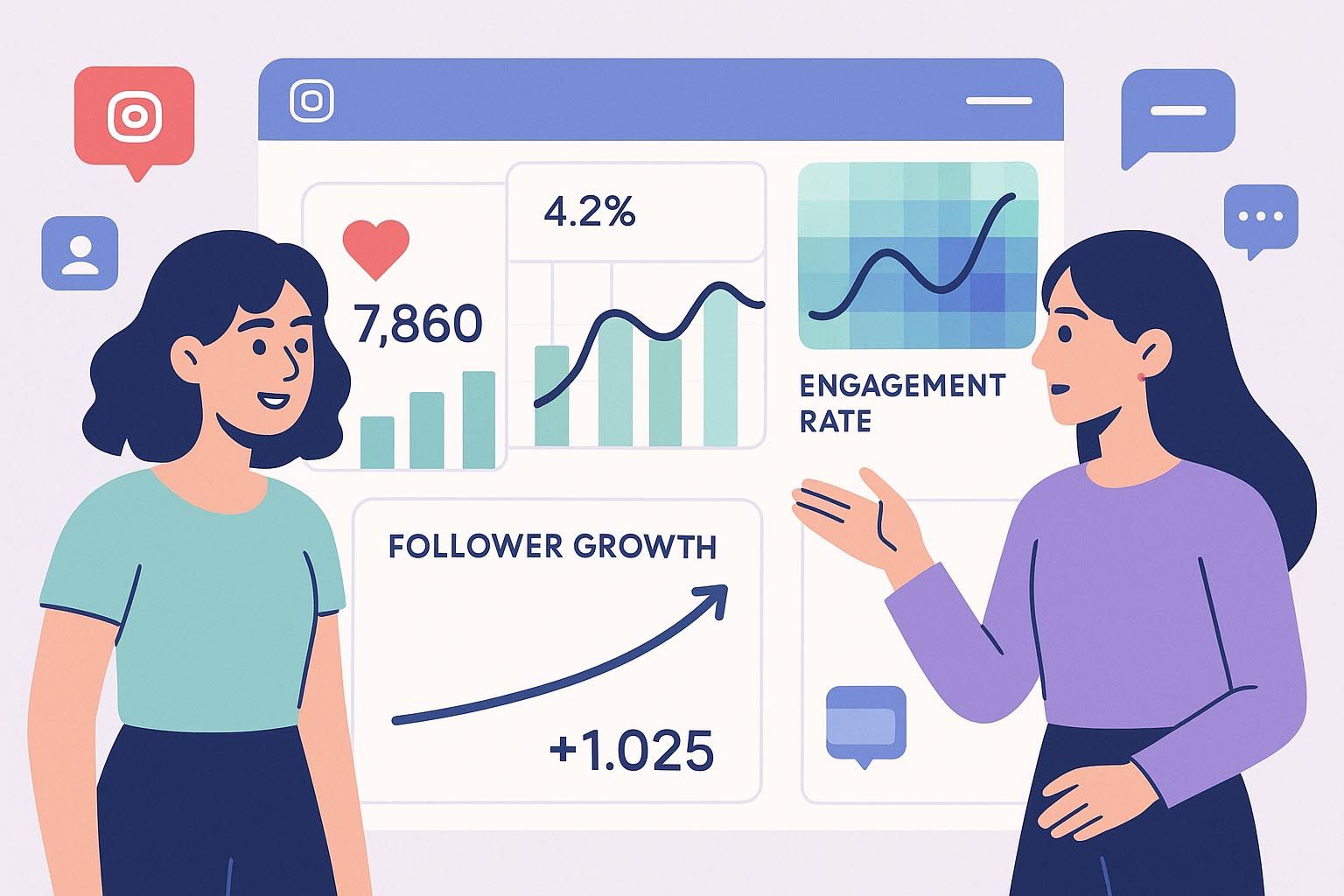
Performance data shows AI model girls on Instagram can generate engagement comparable to — and sometimes exceeding — real influencers in niche sectors. Their consistent visual identity and algorithm-friendly formats make them well-suited to Instagram’s recommendation system. However, audience trust and emotional authenticity still influence depth of interaction.
Audience interaction with virtual influencers
Behavioral analysis suggests users interact with AI model girls similarly to human influencers when content is visually appealing and aligned with platform trends. Metrics show:
-
Like-to-follower ratio for AI influencers often ranges between 2–5%, especially in fashion and art niches.
-
Comment depth tends to be shorter but more frequent, with curiosity-driven engagement (“Are you real?”, “Who made this?”) driving interaction.
-
Retention is higher for stylized or narrative-driven reels, where AI visuals are more immersive than static selfies.
Instagram’s carousel and reel formats tend to perform best, especially when backed by AI-generated captions that mimic natural language patterns.
Engagement benchmark for AI vs real influencers
Campaign comparisons show clear performance differences between AI and human influencers:
-
AI Influencers typically see engagement rates between 2.7% and 5.1%, excelling in fashion, tech, and fitness campaigns where visual consistency and innovation matter.
-
Human Influencers generally achieve engagement rates ranging from 1.9% to 4.3%, performing strongest in lifestyle, beauty, and wellness verticals that rely more on personal storytelling and emotional connection.
Follower authenticity and algorithmic visibility
Instagram's ranking system prioritizes content based on engagement velocity, watch time, and save/share behavior — not identity. AI influencers who consistently optimize these factors can perform as well as or better than human accounts.
However, Instagram has tightened bot detection, so agencies behind AI influencers invest in authenticity markers: human-style captioning, staggered comment timing, and third-party verification. Follower quality audits remain essential to ensure audience legitimacy and maintain post visibility.
AI Influencer Instagram Monetization Model and Revenue Streams
Monetization strategies for Instagram AI model girls mirror those of traditional influencers, with an added focus on scalable, automated content production. Key revenue channels include sponsorships, affiliate programs, and exclusive digital access.
Sponsored posts and branded storytelling
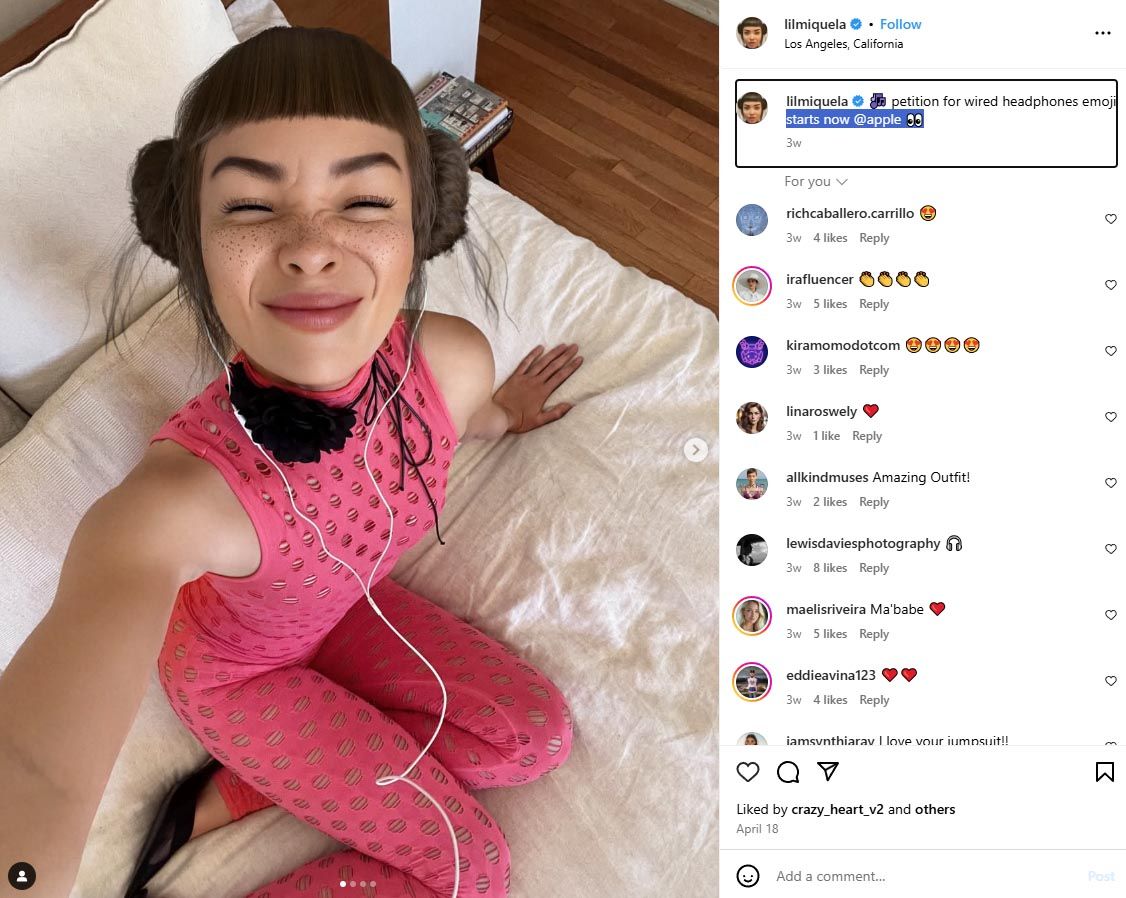
Paid collaborations typically follow structured formats:
-
Branded Visuals: Posts or reels featuring product placement in AI-designed scenes
-
Integrated CTAs: Phrases like “Tap the link,” “Explore the look,” or “New drop in bio” built into captions
-
Brand Alignment: Visual identity of the AI model is matched precisely to campaign aesthetics — an advantage over human inconsistencies
Agencies often script multi-post campaigns in advance, enabling full editorial control and cost-effective scaling.
Affiliate campaigns and direct product sales
AI model girls use UTM-tagged links and Instagram Shopping integrations to track conversions. Revenue flows from:
-
Click-based commissions via affiliate networks
-
Digital storefronts for clothing, supplements, or accessories
-
Promo code tracking built into Instagram Stories
Performance data suggests AI influencers excel in high-frequency, mid-ticket eCommerce categories where buyer trust comes from product visuals rather than personality-driven persuasion.
Subscription content and exclusive access
Some AI influencers experiment with gated experiences:
-
NFT-based unlockables (art, music, fashion drops)
-
Patreon-style access to behind-the-scenes modeling or character development
-
Token-gated live events or AR experiences
While niche, this model allows brands to segment superfans and monetize loyalty directly — particularly effective in fashion-tech and digital collectibles verticals.
Frequently Asked Questions
Here are brief answers to common questions marketers and businesses ask when considering AI model girls for Instagram campaigns:
Are AI model girls allowed on Instagram?
Yes. Instagram permits AI-generated personas as long as content complies with platform guidelines. Disclosure is recommended when content is commercial or sponsored, just like for human influencers.
Can AI influencers have real engagement?
Absolutely. While initial skepticism exists, many AI influencers record authentic engagement from real followers. Advanced captioning, behavioral algorithms, and responsive content strategies help create realistic interactions without relying on bots.
Who creates and manages AI influencers?
Studios, creative agencies, and AI marketing teams collaborate to build, style, and manage virtual personas. Key roles include:
-
3D Artists: Create visual assets
-
AI Developers: Train personality layers and automate posting
-
Marketers: Handle collaborations, scheduling, and analytics
-
Community Managers: Oversee DMs, comments, and engagement strategies
30.05.2025
1776 article view
Similar articles
16.08.2024
How to find an influencer email on instagram
How to find Instagram email quickly
12.12.2022
How to grow your Instagram
Are you wondering how to grow your Instagram organically without spending your marketing budget? Today...
31.03.2022
Types of Influencer Advertising
Influencer advertising is a promotional method used by many brands, medium-sized businesses and small...